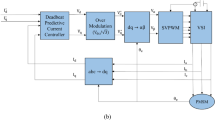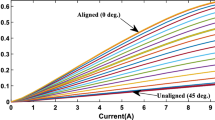Abstract
An improved adaptive sliding mode controller (ASMC) based on a combined state/disturbance observer (CSO) is proposed for the high-performance control of permanent magnet synchronous motor (PMSM). In order to estimate the unknown state and the disturbance including the parameter uncertainty and the external disturbance, the CSO is proposed. Different from the extended state observer (ESO) or generalized ESO (GESO), the CSO uses the linear combination of the extended high-order states to construct the new estimation. The CSO resolves the contradiction between the estimation accuracy and the noise insensitivity, so it is more applicable to time-varying disturbances. Then, the CSO and the ASMC are integrated in the PMSM speed controller by the feed-forward compensation to enhance the system robustness. A simple nonlinear adaptive law is presented to solve the unknown upper bound of the estimation error and minimize the chattering. The theoretical analysis shows that the global stability of the closed-loop system is strictly guaranteed. The simulation and experimental results are presented to demonstrate the effectiveness of the proposed control method.



























Similar content being viewed by others
References
Bolognani S, Zordan M, Zigliotto M (2000) Experimental fault-tolerant control of a PMSM drive. IEEE Trans Ind Electron 47(5):1134–1141
Kim S (2019) Moment of inertia and friction torque coefficient identification in a servo drive system. IEEE Trans Ind Electron 66(1):60–70
Choi HH, Kim EK, Yu DY (2017) Precise PI speed control of permanent magnet synchronous motor with a simple learning feedforward compensation. Electr Eng 99(1):133–139
Du B, Wu S, Han S, Cui S (2016) Application of linear active disturbance rejection controller for sensorless control of internal permanent-magnet synchronous motor. IEEE Trans Ind Electron 63(5):3019–3027
Li S, Liu Z (2009) Adaptive speed control for permanent-magnet synchronous motor system with variations of load inertia. IEEE Trans Ind Electron 56(8):3050–3059
Errouissi R, Al-Durra A, Muyeen SM (2017) Continuous-time model predictive control of a permanent magnet synchronous motor drive with disturbance decoupling. IET Electr Power Appl 11(5):697–706
Young KD, Utkin VI, Ozguner U (2002) A control engineer’s guide to sliding mode control. IEEE Trans Control Syst Technol 7(3):328–342
Kommuri SK, Defoort M, Karimi HR (2016) A robust observer-based sensor fault-tolerant control for PMSM in electric vehicles. IEEE Trans Ind Electron 63(12):7671–7681
Sant AV, Rajagopal KR (2009) PM synchronous motor speed control using hybrid fuzzy-PI with novel switching functions. IEEE Trans Magn 45(10):4672–4675
Lin CH (2015) Dynamic control of V-belt continuously variable transmission-driven electric scooter using hybrid modified recurrent Legendre neural network control system. Nonlinear Dyn 79(2):787–808
Utkin VI (2002) Sliding mode control design principles and applications to electric drives. IEEE Trans Ind Electron 40(1):23–36
Lv L, Li C, Li G (2017) Projective synchronization for uncertain network based on modified sliding mode control technique. Int J Adapt Control Signal Process 31(3):429–440
Rao DV, Sinha NK (2013) A sliding mode controller for aircraft simulated entry into spin. Aerosp Sci Technol 28(1):154–163
Milosavljevic C, Perunicic-D B, Veselic B, Petronijevic M (2017) High-performance discrete-time chattering-free sliding mode-based speed control of induction motor. Electr Eng 99(2):583–593
Li S, Zhou M, Yu X (2013) Design and implementation of terminal sliding mode control method for PMSM speed regulation system. IEEE Trans Ind Inform 9(4):1879–1891
Repecho V, Biel D, Arias A (2018) Fixed switching period discrete-time sliding mode current control of a PMSM. IEEE Trans Ind Electron 65(3):2039–2048
Boiko I (2013) Chattering in sliding mode control systems with boundary layer approximation of discontinuous control. Int J Syst Sci 44(6):1126–1133
Martinez MI, Susperregui A, Tapia G (2017) Second-order sliding-mode-based global control scheme for wind turbine-driven DFIGs subject to unbalanced and distorted grid voltage. IET Electr Power Appl 11(6):1013–1022
Pisano A, Davila A, Fridman L (2008) Cascade control of PM-DC drives via second-order sliding mode technique. IEEE Trans Ind Electron 55(11):3846–3854
Djemai M, Busawon K, Benmansour K (2011) High order sliding mode control of a DC motor drive via a switched controlled multi-cellular converter. Int J Syst Sci 42(11):1869–1882
Li S, Zong K, Liu H (2011) A composite speed controller based on a second-order model of permanent magnet synchronous motor system. Trans Inst Meas Control 33(5):522–541
Wang Q, Ran M, Dong C (2017) On finite-time stabilization of active disturbance rejection control for uncertain nonlinear systems. Asian J Control 20:415–424
Yao J, Jiao Z, Ma D (2014) Adaptive robust control of DC motors with extended state observer. IEEE Trans Ind Electron 61(7):3630–3637
Wu D, Zhou S, Xie X (2011) Design and control of an electromagnetic fast tool servo with high bandwidth. IET Electr Power Appl 5(2):217–223
Liu J, Vazquez S, Wu L (2017) Extended state observer based sliding mode control for three-phase power converters. IEEE Trans Ind Electron 61(1):22–31
Lu X, Lin H, Han J (2016) Load disturbance observer-based control method for sensorless PMSM drive. IET Electr Power Appl 10(8):735–743
Shao XL, Wang HL (2015) Performance analysis on linear extended state observer and its extension case with higher extended order. Control Decis 30(5):815–822
Godbole AA, Kolhe JP, Talole SE (2013) Performance analysis of generalized extended state observer in tackling sinusoidal disturbances. IEEE Trans Control Syst Technol 21(6):2212–2223
Guan C, Pan SX (2008) Adaptive sliding mode control of electro-hydraulic system with nonlinear unknown parameters. Control Eng Pract 16(11):1275–1284
Zou Q, Qian LF, Kong JS (2015) Adaptive enhanced sliding mode control for permanent magnet synchronous motor drives. Int J Adapt Control Signal Process 29(12):1484–1496
Fei J, Ding H (2012) Adaptive sliding mode control of dynamic system using RBF neural network. Nonlinear Dyn 70(2):1563–1573
Lian RJ (2014) Adaptive self-organizing fuzzy sliding mode radial basis-function neural-network controller for robotic systems. IEEE Trans Ind Electron 61(3):1493–1503
Plestan F, Shtessel Y, Bregeault V (2013) Sliding mode control with gain adaptation-application to an electropneumatic actuator. Control Eng Pract 21(5):679–688
Shi T, Wang Z, Xia C (2015) Speed measurement error suppression for PMSM control system using self-adaption Kalman observer. IEEE Trans Ind Electron 62(5):2753–2763
Yan Y, Ji B, Shi T (2015) Two-degree-of-freedom proportional integral speed control of electrical drives with Kalman-filter-based speed estimation. IET Electr Power Appl 10(1):18–24
Acknowledgements
This work was supported by the Fundamental Research Funds for the Central Universities.
Author information
Authors and Affiliations
Corresponding author
Additional information
Publisher's Note
Springer Nature remains neutral with regard to jurisdictional claims in published maps and institutional affiliations.
Appendices
Appendix A
Proof
Define the following state variables: \( x_{0} = \int_{0}^{t} {x_{1} (t)} {\text{d}}t \), \( x_{ - 1} = \int_{0}^{t} {x_{0} (t){\text{d}}t} \), …, and \( x_{{1 - r_{1} }} = \int_{0}^{t} {x_{{1 - (r_{1} - 1)}} (t){\text{d}}t} \), the system (6) can be rewritten as
For system (A1), a GESO is designed as
where \( \xi_{1} = \eta_{{1 - r_{1} }} - x_{{1 - r_{1} }} \), \( k_{i} = \left( {n + 2} \right)!/i! \times (n + 2 - i)! \), and \( - \omega_{0} \) is the desired pole. Supposing \( \xi = [\xi_{1} , \ldots ,\xi_{n + 2} ] = [\eta_{{1 - r_{1} }} - x_{{1 - r_{1} }} ,\eta_{{1 - (r_{1} - 1)}} - x_{{1 - (r_{1} - 1)}} , \ldots ,\eta_{{n + 2 - r_{1} }} - x_{{n + 2 - r_{1} }} ] \), and subtracting (A1) from (A2) we have
By using Laplace transform of (A2) and (A3), the following equation can be obtained
Comparing (A4) with (17), it can be seen that \( \hat{x}_{2} (s) = \eta_{2} (s) \), so \( \hat{x}_{2} (t) = \eta_{2} (t) \). Then using the theorem in [27], for GESO (A2), there is \( \lim_{t \to \infty } \left| {\eta_{2} - x_{2} } \right| \le O(\varepsilon^{{n + 1 - r_{1} }} ) \), where ε = 1/ω0. Thus \( \lim_{t \to \infty } \left| {\hat{x}_{2} - x_{2} } \right| \le O(\varepsilon^{{n + 1 - r_{1} }} ) \) is satisfied. Similarly, \( \lim_{t \to \infty } \left| {\hat{D} - D} \right| \le O(\varepsilon^{{n - r_{2} }} ) \) can be proved. Thus, Theorem 1 is proved.
Here, the existing results of GESO are used in the proof of Theorem 1. And it can be seen that the GESO (A2) achieves the same estimation as the CSO. However, (A2) cannot be implemented because the “integral saturation” problem will appear when calculating x0, \( x_{ - 1} \), …, \( x_{{1 - r_{1} }} \). The CSO uses the linear combination of the extended high-order states to generate the unknown state and disturbance estimations, so this problem is eliminated.
Appendix B
Proof
When x = 0, it can be easy known f(0) = 0. When x > 0, if k < kd, defining \( g(x) = f^{'} (x) = - 2k_{s} x - (k - k_{d} ) + \frac{1}{\lambda }(k - k_{d} )k_{m} px^{p - 1} \), then \( g^{'} (x) = - 2k_{s} + \frac{1}{\lambda }(k - k_{d} )k_{m} p(p - 1)x^{p - 2} \) can be obtained. Supposing \( g^{'} (x_{0} ) = 0 \), we have
It can be known that x0 > 0. Noting \( g^{''} (x_{0} ) = (k - k_{d} )k_{m} {{p(p - 1)(p - 2)x_{0}^{p - 3} } \mathord{\left/ {\vphantom {{p(p - 1)(p - 2)x_{0}^{p - 3} } \lambda }} \right. \kern-0pt} \lambda } \), and considering k < kd, 0 < p < 1 and x0 > 0, there is \( g^{''} (x_{0} ) < 0 \). Thus the maximum value of g(x) is g(x0), i.e., g(x) ≤ g(x0). Selecting \( \lambda = {{(k - k_{d} )k_{m} p(p - 1)} \mathord{\left/ {\vphantom {{(k - k_{d} )k_{m} p(p - 1)} {2k_{s} }}} \right. \kern-0pt} {2k_{s} }} \cdot \left[ { - \frac{1}{{2k_{s} }}(k - k_{d} )} \right]^{p - 2} > 0 \), and substituting it into (B1), we have \( x_{0} = - \frac{1}{{2k_{s} }}(k - k_{d} ) \). Substituting x0 into g(x), it yields
Because x0 > 0, there is g(x0) < 0, and thus \( f^{'} (x) = g(x) \le g(x_{0} ) < 0 \) for all x > 0.
If k = kd, there is \( f(x) = - k_{s} x^{2} \), it is obvious that \( f^{'} (x) = - 2k_{s} x < 0 \) for all \( x > 0 \). Therefore, there exists a positive real number λ such that \( f^{'} (x) < 0 \) for all x > 0. And noting that f(0) = 0 and f(x) is continuous, it can be known that \( f(x) \le 0 \) for all \( x \ge 0 \). Lemma 2 is proved.
Rights and permissions
About this article
Cite this article
Ge, Y., Yang, L. & Ma, X. Adaptive sliding mode control based on a combined state/disturbance observer for the disturbance rejection control of PMSM. Electr Eng 102, 1863–1879 (2020). https://doi.org/10.1007/s00202-020-00999-4
Received:
Accepted:
Published:
Issue Date:
DOI: https://doi.org/10.1007/s00202-020-00999-4




